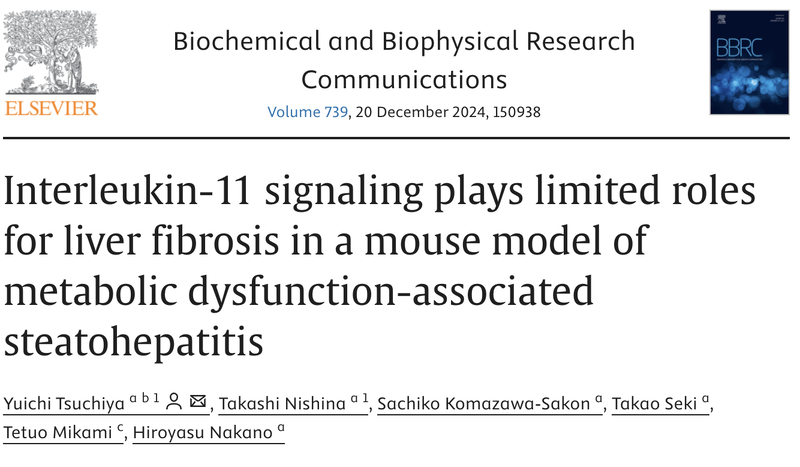新しい論文の発表 Interleukin-11 signaling plays limited roles for liver fibrosis in a mouse model of metabolic dysfunction-associated steatohepatitis
我々のグループから、新たに論文を発表しました。
タイトルは、「Interleukin-11 signaling plays limited roles for liver fibrosis in a mouse model of metabolic dysfunction-associated steatohepatitis」になります。
https://www.sciencedirect.com/science/article/abs/pii/S0006291X24014748
Tsuchiya Y*, Nishina T*, Komazawa-Sakon S, Seki T, Mikami T, Nakano H. Interleukin-11 signaling plays limited roles for liver fibrosis in a mouse model of metabolic dysfunction-associated steatohepatitis. Biochem Biophys Res Commun. 2024 Dec 20;739:150938. Doi: 10.1016/j.bbrc.2024.150938. (*; Co-First Author)
要旨は以下になります。
「肝線維症は、肝臓におけるコラーゲン線維の異常な蓄積であり、ウイルス性肝炎、アルコール性脂肪性肝炎、代謝機能障害関連脂肪性肝炎などの様々な慢性肝疾患によって引き起こされます。慢性肝炎の様々な症状の中で、肝線維症は患者の予後を決定する最も重要な因子です。広範な肝線維症は肝硬変や肝がんにつながり、患者の寿命を縮めます。しかし、現在肝線維症の治療薬は承認されていません。そのため、肝線維症の分子メカニズムと創薬ターゲットの特定が緊急に必要とされています。
インターロイキン11は、炎症及び組織修復の多様なプロセスに関与するインターロイキン6ファミリーの炎症性サイトカインの一つです。最近の報告では、様々な臓器においてインターロイキン11の線維化促進機能も示唆されています。本研究では、急速に肝線維症を発症する代謝機能障害関連脂肪性肝炎のマウスモデルであるコリン欠乏・アミノ酸調整高脂肪食を用いて、肝臓におけるインターロイキン11の線維化促進能を検討しました。この病態モデルにおいて、インターロイキン11は肝臓で特異的に上昇していましたが、インターロイキン11シグナルの欠損は、肝障害、炎症、線維化、およびシグナル伝達経路において軽微な役割しか果たしませんでした。我々の結果は、インターロイキン11の線維化促進機能が臓器や疾患の原因によって異なる可能性があることを示しています。」
すなわち、インターロイキン11(IL-11)は近年、組織の線維化を促進する重要な因子として注目されているものの、本研究結果は、その作用が組織や病態の特異性に依存する可能性を示唆しています。このことから、線維化を伴う疾患におけるIL-11の病態生理学的役割については、各疾患や組織特異的な文脈において慎重な検証が必要であると考えられます。
Our group has recently published a new paper. The title is "Interleukin-11 Signaling Plays Limited Roles for Liver Fibrosis in a Mouse Model of Metabolic Dysfunction-associated Steatohepatitis" https://www.sciencedirect.com/science/article/abs/pii/S0006291X24014748
Tsuchiya Y*, Nishina T*, Komazawa-Sakon S, Seki T, Mikami T, Nakano H. Interleukin-11 signaling plays limited roles for liver fibrosis in a mouse model of metabolic dysfunction-associated steatohepatitis. Biochem Biophys Res Commun. 2024 Dec 20;739:150938. Doi: 10.1016/j.bbrc.2024.150938. (*; Co-First Author)
Abstract:
Liver fibrosis, an abnormal accumulation of collagen fibers in the liver, is caused due to several chronic liver diseases including viral hepatitis, alcoholic steatohepatitis, and metabolic dysfunction-associated steatohepatitis. Among the various symptoms of chronic hepatitis, liver fibrosis is the most crucial factor in determining patient prognosis. Extensive liver fibrosis leads to cirrhosis and liver cancer and shortens the lifespans of patients. However, no drug is currently approved for the treatment of liver fibrosis. Therefore, the identification of molecular mechanisms and druggable targets of liver fibrosis is urgently needed. Interleukin-11 is a member of the interleukin-6 family of inflammatory cytokines that is involved in multiple processes of inflammation and tissue repair. Recent reports also suggest the pro-fibrogenic function of interleukin-11 in various organs. In this study, we examined the fibrogenic potential of interleukin-11 in the liver using a choline-deficient, amino acid-defined high-fat diet, a mouse model of metabolic dysfunction-associated steatohepatitis that rapidly develops liver fibrosis. Although interleukin-11 was specifically upregulated in the liver in this pathological model, the loss of interleukin-11 signaling played minor roles in liver injury, inflammation, fibrosis, and signal transduction pathways. Our results indicate that the pro-fibrogenic function of interleukin-11 may vary among organs and disease etiologies.
In other words, while interleukin-11 (IL-11) has recently garnered attention as a significant factor promoting tissue fibrosis, our research findings suggest that its effects may depend on tissue and pathological specificity. This indicates that the pathophysiological role of IL-11 in diseases involving fibrosis requires careful verification within the context of each specific disease and tissue.


